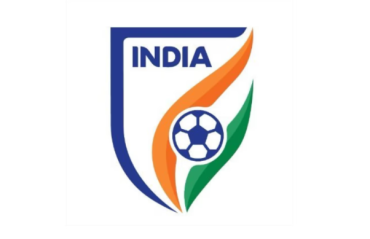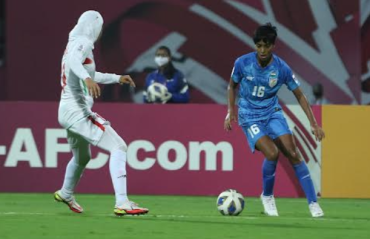SUNBURNT TERRACE - Women's Asian Cup debacle is not about blame, but a question of foresight for AIFF
- By Chiranjit Ojha

- January 23, 2022

WHAT MORE IS THERE to say.
The Indian women's team had been building up to this for two years. In 2019 when the Blue Tigresses had their most active year ever and almost reached the third round of Olympic Qualifiers, that was seen as a perfect preamble to something epic on the cards: the AIFF would apply for and win the bid to host the Women's Asian Cup, and an ascending Blue Tigresses would use the ferocious home support to reach for the unthinkable: a place in the 2023 FIFA Women's World Cup.
And when the groupings for the tournament came out, this crazy notion started to look like a possibility. A distant one, but a possibility nonetheless. India were to take on a relatively weak Iran side and Chinese Taipei whom they had just beaten in a friendly. Wins in both matches would get them into the quarter finals even if they lost to China in the last group stage game. Then, they would face a team like Philippines or Thailand; where it would not be the toughest task to eke out a victory and make it into the World Cup. And even if they lost, they would have two more chances at getting in through continental or inter-continental playoffs.
A real world cup spot earned by merit. It would be the biggest feat ever in the history of Indian football. Beyond what most fans even dare to dream of, that too so quickly.
The tournament was to bring a bounty for men's football as well. A successful Women's Asian Cup would be the perfect proof of concept to include for AIFF in the bid to host the next big AFC competition: the men's Asian Cup. And if the Blue Tigers managed to do something memorable, fuelled by home support, that was going to set the stage for an improved Indian men's team to get into the expanded FIFA World Cup by 2030. And maybe India would think about hosting the World Cup too; the ultimate prize in global football for any Federation.
But the whole thing got cut short in the very first step. Of course, India can still turn heads around the world with the FIFA U-17 Women's World Cup later this year. But the dream of hosting the men's Asian Cup may have received a postponement.
And most of all, that dream of qualifying for the FIFA Women's World Cup 2023 that had suddenly become a possibility in the last few months has been ruthlessly snuffed out due to 13 players testing positive of COVID-19. India are out of the Women's Asian Cup after playing just one match.
The sheer injustice of it all is hard to fathom at first glance. The fans are livid with anger, and they are demanding answers from the AIFF: how could this happen? The Federation is handling it in the worst way possible.
Praful Patel, the AIFF President, was immediately busy shielding himself from all possible blame by hiding behind the players,
“The team is heartbroken, and I request all to respect their feelings and sentiments. I am proud of the great promise the team showed in their first match, and am confident that they will prove their mettle in the near future... this is not the end of the world. The promise on display in the first match against IR Iran was there for all to see, and am confident they will bounce back from this temporary setback.”
It's unclear who, and when, was not being respectful to the players' feelings and sentiments. For the Blue Tigresses, there's only messages of solidarity and wishes for the speedy recovery of the infected.
The AIFF brass were always keen to take credit when their ambitious plan was coming together well, and rightfully so. But when the plan fell apart, they suddenly weren't keen on accepting responsibility.
Unfortunately, this happened to us despite the best measures put in place, and it is sheer bad luck that it happened to us. Let there be no fingers pointed at any. We need to understand this is a pandemic situation, and no bubble is foolproof around the world.@IndianFootball
— Praful Patel (@praful_patel) January 23, 2022
This behaviour does not come as a surprise to anyone. And it's unlikely that any concrete information regarding how the bubble breach happened would be made public. But if we were to speculate: two members of the team had tested positive on 19th January, and if they were to be the original cases within the bubble, then the timeline fits; the 13 new cases were detected right on the 4-5 day mark from the original breach.
Again, this is a guess; but we are unlikely to have any more data to go by, at least for now.
It's still a matter of bad luck that so many players tested positive at the same time. Had it been a few less, India still would be able to field a team and have a fighting chance at turning this around. And even if they failed, at least they would have failed on the pitch. The Sorrow of Sharjah in 2019 was heartbreaking, but the players & fans had the closure of knowing that they had gotten a fair result. But not even being able to have their shot after months of hard work and sacrifice living in a bubble away from friends & family... that's going to sting for a long time. And unfortunately not all the players in this team will get a chance to right this wrong.
And it is for their sake that we need some questions to be answered.
Although the AIFF President would like everyone to stop "pointing fingers" on account of the players, the players who were just deprived of the biggest moment of their professional careers so far, and the fans who supported them all the way, deserve to know why the tournament went ahead under these circumstances in the first place.
It's not about assigning blame but a matter of foresight.
By the first week of December 2021, the Omicron variant had already begun to circulate in India. Multiple festivals were coming up and there was a steady increase in the number of cases in many states including Maharashtra. And everyone knew that throughout December and January multiple festive occasions would push the numbers higher; as they did last year. Many major cities in the country had to implement weekend curfews, evening curfews or came dangerously close to full lockdown.
Soon it was also obvious that the standard protocols for conducting a bio-bubble (Originally designed for older COVID strains) were not enough to contain this new, extra-contagious variant. All three sporting bubbles in the country, namely the I-League, ISL and Pro Kabaddi, experienced bubble breaches. In fact, by early January, the AIFF itself had to postpone the I-League for over a month. In the ISL and the PKL multiple matches had to be postponed.
Now, the AIFF always knew that while a team in I-League or ISL had the luxury of having its matches postponed to a latter date in case it was unable to field enough players due to a COVID-19 outbreak, teams in the Women's Asian Cup would immediately get thrown out of the tournament.
The margin for error in the Women's Asian Cup was far smaller than ISL or I-League. And since it was an international tournament where players would be exempt from quarantine upon arrival from abroad, there was a much higher chance of cases getting through.
Basically, the risk of something going wrong was exponentially higher at the Women's Asian Cup and everyone knew it.
Which brings us to the question: why didn't the AIFF seek to postpone the tournament until the summer? There were enough valid reasons to do so. The 'force majeure' clause that the Federation will cite now to avoid further penalties for failing to field the team would have sufficed to request a postponement, too.
It's not like the AIFF isn't taken seriously by the AFC. In fact the AFC has gone to great lengths to help out the Indian FA. One only needs to look at the way the Indian domestic league system was restructured by AFC to know how much importance the continental body puts on the Indian market.
Most Asian countries wouldn't mind the hot April weather. And the Blue Tigresses might have had a chance to play in front of the home crowd; which is the single biggest reason to host an international tourament anyway. The Omicron strain could also have burned itself out, like it has in many other countries. There are many experts who are already predicting that the third wave will peak in India around February, and the numbers would go down from there.
Not to mention, there would be enough time to have health protocols and bio-bubble SOPs updated to handle Omicron.
In short, postponing the tournament would have made it much safer to host.
But the AIFF decided to go ahead with the competition and the Indian women's national team had to pay the biggest price for it.
Whoever in the Federation thought asking for postponement would make them look bad should consider if this makes them look worse.
And the tournament is far from over, so there remains the risk that some other team may also suffer the same fate as the Blue Tigresses. What if it's a title contender that gets thrown out due to COVID? What COVID plays a major role in determining who ends up with the championship? Would that be a worse outcome than the tournament being pushed back by a couple of months, or not?
It's understandable that a postponement would have caused scheduling conflicts with domestic tournaments (e.g. IWL) and such. But again, would that not have been a smaller problem to deal with than the risks that came with hosting the tournament now?
Pointing fingers over the bubble breach is not a productive undertaking by any means. But not answering the questions regarding foresight and risk management would leave us at risk of this catastrophe repeating itself.
Answers are owed. Because at the end of the day, when something like this happens, it's the players who pay the price, not the Federation. And with every dream of going toe to toe with Asia's best or fighting for a World Cup berth getting lost in the dark, Indian football takes a stumbling step backwards.
Get the latest in the world of Sports, Teams, and Players! Free Delivery to your Inbox.





























